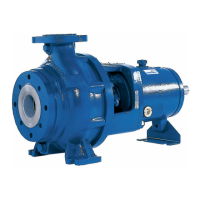2. Fully open the shut-off element in the suction line.
3.
Fully open all auxiliary connections (barrier fluid, flushing liquid, etc).
6.1.5 Water cooling
CAUTION
Deposit forming, aggressive cooling water
Damage to the pump!
▷ Observe the cooling water quality.
Observe the following quality data of the cooling water:
▪ Not deposit forming
▪ Not aggressive
▪ Free from suspended solids
▪ Hardness on average 5 °dH (~1mmol/l)
▪ pH > 8
▪ Conditioned and neutral with regard to mechanical corrosion
▪ Inlet temperature t
E
= 10 to 30 °C
Outlet temperature t
A
= maximum 45 °C
6.1.6 Final check
1. Remove the coupling/belt guard and step guard, if any.
2.
Check the alignment of coupling/belt drive (⇨ Section 5.6 Page 29); re-align, if
required. (⇨ Section 5.7 Page 32)
3. Check the function of coupling/shaft/belt drive.
Check that coupling/shaft can easily be rotated by hand.
4. Reinstall the coupling/belt guard and step guard, if any.
5. Check the distance between coupling and coupling guard or V-belt and belt
guard.
The coupling guard must not touch the coupling; the belt guard must not touch
the pulleys.
6.1.7 Start-up
DANGER
The permissible pressure and temperature limits will be exceeded if the pump is
operated with the suction and discharge lines closed.
Explosion hazard!
Leakage of hot or toxic fluids!
▷ Never operate the pump with the shut-off elements in the suction line and/or
discharge line closed.
▷ Only start up the pump set with the discharge side gate valve slightly or fully
open.
DANGER
Excessive temperatures due to dry running or excessive gas content in the fluid handled
Explosion hazard!
Damage to the pump set!
▷ Never operate the pump set without liquid fill.
▷ Prime the pump as specified. (⇨ Section 6.1.4 Page 39)
▷ Always operate the pump within the permissible operating range.
6 Commissioning/Start-up/Shutdown
40 of 78
KWP

